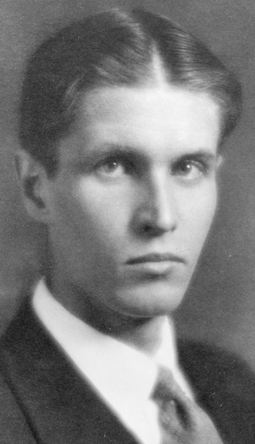


Douglas Gordon Campbell was a medical doctor and psychiatrist who promoted General Semantics in many journal articles throughout the 1930s. He was one of the original 4 trustees of the Institute. He divorced and remarried in 1940, then vanished from General Semantics following the suicide in 1942 of his ex-wife.
Douglas Kelley, a medical doctor and psychiatrist, attended a seminar presented by Korzybski in 1939 and later presented at Korzybski's seminars and conferences, usually on the topic of magic and deception. In 1958 Dr. Kelley committed suicide in front of his family. Kelley is most famous today as a psychiatrist who evaluated the leading Nazi prisoners at Nuremburg after World War 2. Kelley killed himself in the same manner as his most famous patient, Herman Goering -- swallowing a cyanide capsule.
Then there was Guthrie Janssen, born 1916. He became interested in General Semantics while teaching English in Egypt during World War 2. He attended a seminar with Korzybski in Chicago in 1945 and obtained a scholarship to study with Korzybski the following year. The major fruit of his work for Korzybski was an abridged version of Science and Sanity condensed to fewer than 300 pages -- "Selections from Science and Sanity" -- which was published in 1948. Janssen continued to assist Korzybski at his Institute in Connecticut until he married dermatologist Guila Beattie, another student of Korzybski's. The couple lived near the Institute and named their first child, born in 1949, "Alfred." Janssen wrote a fond remembrance of Korzybski after his death in 1950, and hailed Korzybski's engineering attitude as opposed to sentimental and metaphysical approaches. Janssen published two short books related to General Semantics in 1950 -- Basic Human Engineering Handbook and A Salesman's Handbook Course in Human Engineering. Then silence. Within 4 years, the Janssen's disappeared from the GS map. (1)

The Janssens migrated from the east coast to Oregon in 1964 where he died in 1990 and she died in 2003. They are buried in Pleasant View Cemetery in Clackamas County, Oregon. Apparently Guthrie shed most of his GS training and became a fundamentalist Christian. His only book after 1950 was "To love is to obey: living the commands of Jesus," which was published in 1986. Here's an abstract:
Guthrie E. Janssen
Holy Cross Orthodox Press, Jan 1, 1986 - Religion - 187 pages
The life of a Christian is to be a life of love and obedience to the commands of Jesus Christ. How is this to be done in the "desert" of today's secular world? In this book Guthrie E. Janssen, an Orthodox layman, brings to bear the depths of wisdom (which is a word for Christ) as perceived by the early fathers of the Church whose "desert" was in its essentials little different from our own. He shows that love grows through obedience, and obedience through love, and that all is encompassed in the experience of the Church, which is that setting in which we experience the kingdom of God that is both here and now and yet to come. Written for Orthodox and non-Orthodox Christians alike, this is a book to excite the Christian imagination and show the way for churches in the West today to experience renewal and recover the joy, power, and authority known by the early Church. It is not a manual of techniques but distinctly practical in showing us specifically how to acquire the wisdom that is truly the Way of Life Christ means us to live in him.
Guthrie adopted the honorary title "Deacon Germanos," perhaps reminiscent of "Count Korzybski," and had it engraved on his tombstone.
In Guthrie's last article, a religious tract published posthumously, there does not appear to be any signs of GS left in him.
Here's a previous article in a similar semantics.
Perhaps Guthrie was searching for Jesus all along, and mistook Korzybski for the messiah. Perhaps Jesus offered Guthrie eternal life, whereas GS could offer only consciousness of abstracting.
Guthrie and Guila sired 2 children -- Alfred in 1949, who was named for Korzybski, and Frances. Alfred now goes by the name "Al Janssen." After graduating from Linfield College in Portland Oregon in 1971 with degrees in math and education Al became a writer for Campus Crusade for Christ. He and his wife live in Colorado Springs, CO, where he heads a Christian evangelical organization called Open Doors International. Perhaps the son's math interests were seeds implanted early by his father but which, too, failed to flower.